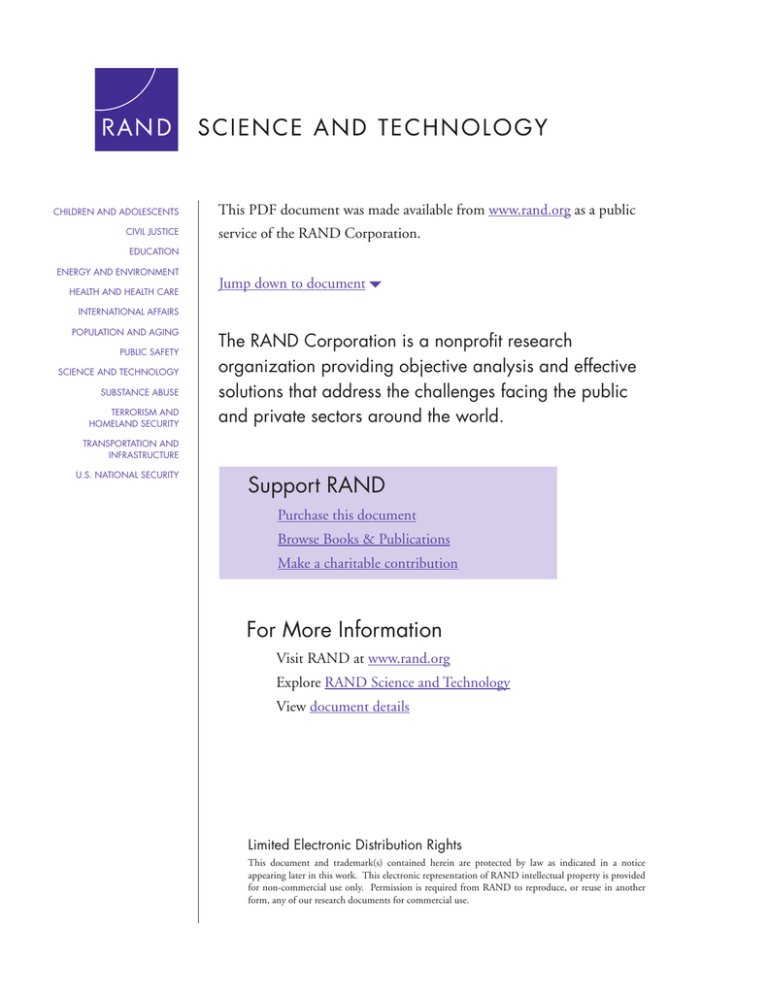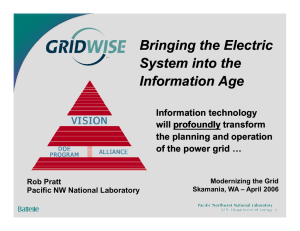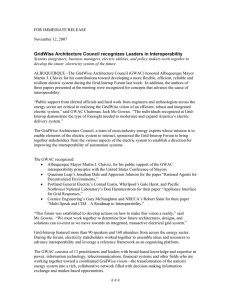
CHILDREN AND ADOLESCENTS
CIVIL JUSTICE
This PDF document was made available from www.rand.org as a public
service of the RAND Corporation.
EDUCATION
ENERGY AND ENVIRONMENT
HEALTH AND HEALTH CARE
Jump down to document6
INTERNATIONAL AFFAIRS
POPULATION AND AGING
PUBLIC SAFETY
SCIENCE AND TECHNOLOGY
SUBSTANCE ABUSE
TERRORISM AND
HOMELAND SECURITY
The RAND Corporation is a nonprofit research
organization providing objective analysis and effective
solutions that address the challenges facing the public
and private sectors around the world.
TRANSPORTATION AND
INFRASTRUCTURE
U.S. NATIONAL SECURITY
Support RAND
Purchase this document
Browse Books & Publications
Make a charitable contribution
For More Information
Visit RAND at www.rand.org
Explore RAND Science and Technology
View document details
Limited Electronic Distribution Rights
This document and trademark(s) contained herein are protected by law as indicated in a notice
appearing later in this work. This electronic representation of RAND intellectual property is provided
for non-commercial use only. Permission is required from RAND to reproduce, or reuse in another
form, any of our research documents for commercial use.
This product is part of the RAND Corporation technical report series. Reports may
include research findings on a specific topic that is limited in scope; present discussions of the methodology employed in research; provide literature reviews, survey
instruments, modeling exercises, guidelines for practitioners and research professionals, and supporting documentation; or deliver preliminary findings. All RAND
reports undergo rigorous peer review to ensure that they meet high standards for research quality and objectivity.
Estimating the Benefits of
the GridWise Initiative
Phase I Report
WALTER S. BAER, BRENT FULTON,
SERGEJ MAHNOVSKI
TR-160-PNNL
May 2004
Prepared for the Pacific Northwest National Laboratory
The research described in this report was prepared for the Pacific Northwest National
Laboratory by RAND Science and Technology.
ISBN: 0-8330-3641-6
The RAND Corporation is a nonprofit research organization providing objective analysis
and effective solutions that address the challenges facing the public and private sectors
around the world. RAND’s publications do not necessarily reflect the opinions of its research
clients and sponsors.
R® is a registered trademark.
© Copyright 2004 RAND Corporation
All rights reserved. No part of this book may be reproduced in any form by any electronic or
mechanical means (including photocopying, recording, or information storage and retrieval)
without permission in writing from RAND.
Published 2004 by the RAND Corporation
1700 Main Street, P.O. Box 2138, Santa Monica, CA 90407-2138
1200 South Hayes Street, Arlington, VA 22202-5050
201 North Craig Street, Suite 202, Pittsburgh, PA 15213-1516
RAND URL: http://www.rand.org/
To order RAND documents or to obtain additional information, contact
Distribution Services: Telephone: (310) 451-7002;
Fax: (310) 451-6915; Email: order@rand.org
xi
Summary
This report presents the initial (Phase I) results of a two-phase project undertaken
to characterize and estimate the benefits of applying advanced communications
and information technologies, through the GridWise TM initiative, to bring the
aging U.S. electricity grid into the information age.
GridWise is a vision, a concept, and a national initiative developed by the U.S.
Department of Energy (DOE), the Pacific Northwest National Laboratory
(PNNL), and participants from the electricity industry. GridWise seeks to link
electricity suppliers and end-users with high-speed networks that provide realtime information about system capacities, demand, prices, and status. Its
proponents anticipate that the integration of communications and information
with the electricity grid will facilitate competitive, efficient markets for power,
enable each participant to actively manage its own production and consumption
decisions, help the system balance supply and demand under both normal and
stressful conditions, and in general provide diagnostic information and tools to
better manage both system operations and end-user applications.
The essence of GridWise is the revealing of value to all parties through
information and communications, so that the least-cost resources are used to
meet new demand for power and its underlying infrastructure. Markets may be
the simplest and most transparent way to reveal value, but regulatory
approaches using incentives and resource bidding appear workable as well.
Whether in a regulated utility environment or in a deregulated market-based
system, advanced information and communications technologies are the keys to
revealing value and enabling stakeholders to act on the opportunities presented
to them. While this analysis relies on a competitive market model to characterize
and estimate benefits from implementing GridWise, we recognize that such
benefits may also be realized in a regulated system or in one with both
competitive and regulated components.
Smoothing out the daily peaks and valleys of electricity production and
consumption can benefit both electricity suppliers and end-users. With
GridWise, end-users will see time-varying prices that reflect high supply costs
when power consumption peaks and lower costs at other times. Users can then
adjust their peak and off-peak demands, either manually or by programming
their appliances and other electrical equipment to respond to price signals. This
xii
“demand response” will result in less power consumption during high-cost peak
periods and the shift of some peak usage to lower-cost off-peak times. Changes
in power usage due to demand response will generally be greater for commercial
and industrial facilities than for residential end-users. Overall, end-users will
gain from lower expenditures for power, while suppliers will benefit from
reduced operating costs and better utilization of their generation, transmission,
and distribution assets.
Enabling end-users to interact directly with the grid can also help the electricity
system respond to equipment failures, weather-related emergencies, and other
stressful conditions. At present, each of the ten North American Reliability
Council (NERC) regions must maintain enough excess generating capacity to
supply system demand if a large generating unit or transmission line fails. In the
GridWise concept, much of that reserve could be provided by smaller generating
units located at or near end-user sites or by end-user loads themselves. The
GridWise vision of collaborative networks, ubiquitous information flows,
distributed intelligence, and automated control systems promises important
additional benefits in terms of improved power quality, reliability, and security,
as well as energy efficiency.
The Phase I analysis develops a microeconomic framework for making
quantitative estimates of demand response and other benefits from the
widespread implementation and adoption of GridWise. To establish a baseline
without GridWise, we use the projections through 2025 of electricity system
capacities, power consumption, and prices contained in the most recent Annual
Energy Outlook (AEO) published by the U.S. Energy Information Administration.
We then phase in GridWise over 20 years and compare the results with those
from the AEO baseline.
To explore the sensitivity of benefits to the input data and assumptions, we
develop a series of scenarios representing different, but plausible, development
paths for GridWise. Benefits for each scenario are calculated as the present value
over 20 years of the cash flow differences from the AEO baseline projections.
Figure S.1 compares the benefits calculated for five scenarios:
•
A “nominal” scenario with midrange values chosen for important input
variables such as GridWise market penetration among end-users and within
the transmission and distribution (T&D) grid; demand response parameters;
electricity market competitiveness; and GridWise impact on generating
reserve margins, power quality and reliability (PQR), and energy efficiency
in buildings.
xiii
140
Present Value ($ billion)
120
End-users: reduced cost of
outages
100
End-users: lower
expenditures from
increased efficiency
80
60
End-users: lower
expenditures from demand
response
40
Suppliers: deferred and
reduced costs from demand
response
20
0
Nominal
scenario
Highly
Less
High impact Low impact
competitive, competitive, on power
on power
responsive responsive reliability
reliability
markets
markets
Scenario
Figure S.1. Supplier and End-User Benefits from GridWise, by Scenario
•
A highly competitive and responsive markets scenario with higher values
for GridWise market penetration among end-users, demand response,
impact on generating reserve margins, and electricity market
competitiveness.
•
A less competitive and responsive markets scenario with correspondingly
lower values for GridWise market penetration among end-users, demand
response, impact on generating reserve margins, and electricity market
competitiveness.
•
A high-PQR-impact scenario with higher pre-GridWise costs of power
outages and disturbances for end-users and greater GridWise efficacy in
reducing these costs.
•
A low-PQR-impact scenario with less GridWise efficacy in reducing outages
and disturbances.
The systemwide benefits from demand response accrue partly to industry
suppliers (the bottom segment of each bar) and partly to end-users (the next
segment of each bar). The split depends largely on the extent of market
competitiveness and responsiveness. In the nominal scenario, end-users receive
40 percent of the demand response benefits, passed on primarily as lower offpeak prices, which result in lower total expenditures for power. Suppliers receive
the rest, benefiting from deferred and reduced costs that substantially outweigh
the impact of lower end-user spending. Including benefits from improved PQR
xiv
and energy efficiency brings the present value total of benefits to suppliers and
end-users to $81 billion.
When electricity markets are both highly competitive and responsive, end-users
receive an even larger share (60 percent); but the total benefits from demand
response are greater, so the industry suppliers also receive large benefits. Total
benefits, including improved PQR and energy efficiency, rise to $132 billion. In
the less competitive and responsive market scenario, suppliers get most of the
demand response benefits (75 percent), but there is considerably less to divide.
Total benefits, including improved PQR and energy efficiency, are only $32
billion, $100 billion less than those for the highly competitive and responsive
scenario. The last two scenarios in Figure S.1, in which GridWise has high and
low impact on power quality and reliability, yield total benefits of $115 billion
and $70 billion, respectively.
These results clearly show that the estimated gross benefits from GridWise can
be quite large, exceeding $100 billion in two of the five scenarios. However, the
variance among estimates is also very large, depending, of course, on the input
data and assumptions. At this early stage of GridWise development, many of the
input variables and projections are highly uncertain. Consequently, we believe
that delineating the range of benefits based on plausible input variables is more
useful than trying to converge on a single “best estimate.”
Our Phase I analysis does not include quantitative estimates of other categories
of possible GridWise benefits, notably,
•
Lower costs of capital for generation, transmission, and distribution
investments.
•
Integration of smaller-scale, distributed generation and related assets with
the grid.
•
Reduced emissions and other environmental externalities.
•
Intangible benefits.
•
End-user productivity gains.
Based on our preliminary analysis, benefits in the first three categories appear to
have relatively small present values compared with those shown in Figure S.1.
The latter two categories could conceivably yield much larger benefits, but they
depend on assumptions that at this point seem very difficult to validate. In Phase
II of this project, we will evaluate these benefit categories more fully and will
develop estimates of the costs to implement GridWise.






